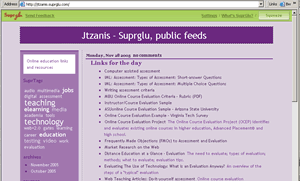Like
Mike, I've been thinking a lot about information overload these days...as well as about how much information anyone can reasonably be expected to track and use.
In
Amy Gahran's post on why her RSS feed list is so long, she cites Ross Mayfield's assertion in “
Attention Saturation” that the maximum number of feeds a person can handle for the purposes of maintaining social relationships is 150. While not taking on the question of this limit for social connections, she goes on to describe the purposes for which she uses different types of feeds - and how she can maintain a list of around 500
Questions for my fellow blogger/aggregators:- How many feeds do you aggregate and how often do you check them?
- What different types of feeds are they?
- What do you think your maximum is?
As for myself, I find that my own comfort level is with a list of about 100-110, and only a handful of these represent "social relationships" to me... by far, the majority of the feeds I check are for reference, research, and work-related purposes.
The "social" blogs I read on a daily basis... The majority of others I check several times a week, furling, bookmarking, and "clip blogging" anything that looks interesting but that I don't have time to fully investigate, and blogging things of particular interest after I've reviewed them further.
I also keep a "watchlist" of new blogs that I check out from time to time to see if they're worth adding to the regular list. In addition, I have a bunch of feeds that are more "for fun" - feeds that I only check when I have some spare time and want to find something interesting or unusual to investigate... and I mark these all as "read" from time to time if I don't have a chance to look at them for a while.
 ....For every item belonging to me as good belongs to you. " (Apologies to Whitman)
....For every item belonging to me as good belongs to you. " (Apologies to Whitman)

